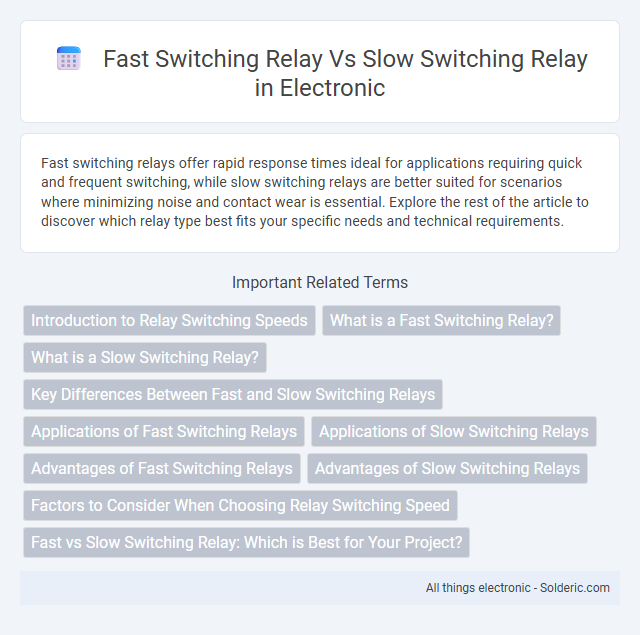Fast switching relays offer rapid response times ideal for applications requiring quick and frequent switching, while slow switching relays are better suited for scenarios where minimizing noise and contact wear is essential. Explore the rest of the article to discover which relay type best fits your specific needs and technical requirements.
Comparison Table
| Feature | Fast Switching Relay | Slow Switching Relay |
|---|---|---|
| Switching Speed | Microseconds to milliseconds | Milliseconds to seconds |
| Common Applications | Telecommunications, high-speed circuits, digital switching | Power control, heating systems, general-purpose switching |
| Contact Life | Shorter due to rapid cycling | Longer under low switching frequency |
| Contact Wear | Higher wear rate from fast operations | Lower wear due to slower operation |
| Power Consumption | Often higher due to fast coil energizing | Typically lower |
| Cost | Higher price for precision and speed | Generally lower cost |
| Noise Level | Lower electromagnetic noise | Higher noise and mechanical hum |
Introduction to Relay Switching Speeds
Fast switching relays operate with response times typically under 1 millisecond, making them ideal for applications requiring rapid circuit control such as telecommunications and signal processing. Slow switching relays, with switching speeds ranging from tens to hundreds of milliseconds, suit power control systems where switching speed is less critical but higher current capacity is necessary. Your choice between fast and slow switching relays depends on the required speed for circuit activation and the electrical load specifications.
What is a Fast Switching Relay?
A fast switching relay is an electromechanical or solid-state device designed to rapidly open and close electrical circuits, typically operating in milliseconds or microseconds. It is commonly used in applications requiring high-speed signal transmission, precise control, and minimal contact bounce, such as telecommunications, automation systems, and high-frequency switching. Fast switching relays enhance performance by reducing switching time and improving the overall response speed of electronic circuits.
What is a Slow Switching Relay?
A Slow Switching Relay is an electromechanical or solid-state device designed to operate with deliberate time delays, preventing rapid switching that can cause electrical noise or mechanical wear. It is commonly used in applications requiring controlled, gradual activation to protect sensitive equipment and ensure system stability. Slow switching relays are essential in power systems, HVAC controls, and industrial automation for reducing transient stress and enhancing longevity.
Key Differences Between Fast and Slow Switching Relays
Fast switching relays operate with rapid response times, typically in milliseconds, making them ideal for applications requiring quick and precise control such as telecommunications or pulse circuits. Slow switching relays have longer response times, often measured in seconds, and are suited for general switching tasks where speed is less critical, like lighting or motor control. Your choice between fast and slow switching relays depends on the required switching speed, longevity, and the specific electrical load characteristics.
Applications of Fast Switching Relays
Fast switching relays are extensively used in telecommunications equipment, industrial automation systems, and electronic testing devices due to their ability to handle high-speed signal switching with minimal delay. These relays are ideal for applications requiring rapid on/off control in circuits, such as pulse generation, relay logic circuits, and high-frequency signal routing. Their fast response time enhances the performance of automated manufacturing processes and communication networks, where precision and speed are critical.
Applications of Slow Switching Relays
Slow switching relays are commonly used in applications requiring stable, long-duration current control such as HVAC systems, motor starters, and lighting circuits where mechanical wear needs to be minimized. They excel in environments where switching speed is less critical, allowing for reliable operation in industrial machinery and power distribution panels. Their design reduces electrical noise and prevents frequent mechanical stress, enhancing durability in automation and control systems.
Advantages of Fast Switching Relays
Fast switching relays offer significantly higher switching speeds, enabling rapid on/off cycles essential for time-sensitive applications such as telecommunications and automated testing systems. Their reduced response time minimizes signal distortion and enhances precision in controlling electrical circuits, leading to improved overall system performance. These relays also exhibit lower mechanical wear due to fewer moving parts in solid-state designs, resulting in greater longevity and reliability compared to slow switching relays.
Advantages of Slow Switching Relays
Slow switching relays offer enhanced reliability and longer operational lifespan by minimizing wear and tear caused by frequent switching, making them ideal for applications requiring stable, long-duration contacts. They reduce electrical noise and arcing, protecting sensitive components in your system and ensuring consistent performance. Slow switching relays are particularly advantageous in power control and heavy-load environments where durability and contact integrity are critical.
Factors to Consider When Choosing Relay Switching Speed
When choosing relay switching speed, consider the load type and switching frequency as fast switching relays excel in applications requiring rapid on/off cycles, while slow switching relays suit heavy inductive loads to prevent contact wear. Your application's sensitivity to electromagnetic interference and contact arcing should also influence the choice, since fast switching relays typically generate more noise but enable higher precision. Finally, power consumption and relay lifespan matter: slower switching relays often offer greater durability under continuous loads, whereas fast switching relays optimize energy efficiency and response time.
Fast vs Slow Switching Relay: Which is Best for Your Project?
Fast switching relays operate at high speeds, making them ideal for applications requiring rapid on-off cycles, such as automation systems and signal switching. Slow switching relays are better suited for projects where contact wear and electrical noise reduction are priorities, offering greater durability and reliability in low-frequency switching. Your choice depends on the required switching speed, longevity, and the specific demands of your project's electrical environment.
Fast switching relay vs slow switching relay Infographic

 solderic.com
solderic.com